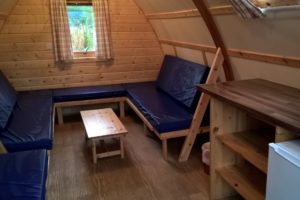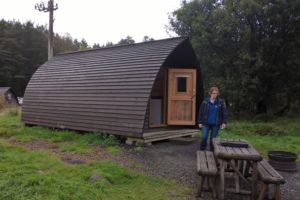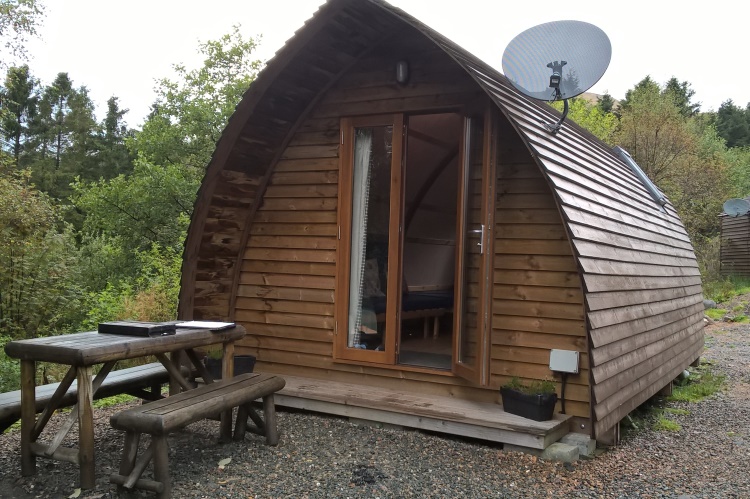Adding some glam to the woods (FWN 29)
20 September 2017Glamping: ‘a form of camping involving accommodation and facilities more luxurious than those associated with traditional camping’ (Oxford Dictionaries).
More and more people are looking for glamping holidays; cheaper than resorts and hotels, in touch with the outdoors but without the gutters and grime so often experienced with camping in Scotland. Tourism statistics, backed by anecdotal evidence, indicate increasing popularity of ‘staycations’ (not going abroad for holidays), and it’s an opportunity not to be missed for those wishing to diversify their land-based incomes.
Glamping sites have appeared in many parts of the country, either as independent businesses or as part of a franchise. One such franchise is Wigwam® Holidays. I spent a September morning at the Strathfillan Wigwam® Cabins near Crianlarich, in the presence of manager Rena Baillie who oversaw the set-up of the site on the farm 23 years ago.
The glamping pod concept was the brain-child of Charles Gullen, now Managing Director of Wigwam® Holidays. Looking to utilise timber from thinnings which at the time was otherwise going to go to waste, he was inspired to mill the timber and build the first-ever glamping pod, with a view to finding locations for them along the West Highland Way. A chance meeting in a pub led to a source of grant funding which kick-started the business, which now has 80 franchises across the UK.
The emphasis of the glamping pod holiday is on low impact; minimal electricity and mod-cons, minimal infrastructure, minimal landscape impact, local produce, low cost to the customer, easy to install and low start-up and running costs.
From Rena and, farming husband, Tom’s point of view there two key advantages to trying out the glamping pod experiment. The first was diversification to boost income. Rena was already running a bed and breakfast and adding a couple of glamping pods seemed like a sensible extension of the hospitality venture. The second was to provide employment for shepherds’ wives who otherwise had little in the way of job opportunities by virtue of the farm’s location.
Site preparation was, and still is, very simple (one of the attractions of the glamping pod set-up), comprising minor site levelling, drainage, laying of hard-core on a footprint just slightly larger than the pod itself, and setting out of concrete blocks for the pod’s feet to sit on. The infrastructure that exists now (car access, power, shop etc) has been built up over the years.
The Wigwam® design has evolved and there are now two types of pod: basic and en-suite, although there are other manufacturers working to an array of specifications. The dimensions are designed to allow easy transport by lorry, and the curved shape maximises standing room while maintaining a ‘tent’ feeling. Interestingly an early version that was based on a typical shed shape, even with en-suite, attracts fewer bookings, suggesting that there is a desire for a form of holiday accommodation which does not feel like ‘just another’ room.
Many of the pods are located in or on the edge of woodland. Rena confesses that she struggled to imagine the damp soggy hollow in the woods being anything other than a miserable hole, but after a few trees were removed to create some small clearings, a little drainage and some hard-core laid, the location was transformed and lent itself to glamping pods. In fact, the pods located wholly within the woodland are the most popular amongst visitors.
The woodland setting is part of the success of the glamping pods. It’s long been known that woodland can carry many more people than the open ground can – not from a physical point of view but psychological; the trees simply hide the people from each other, reducing the perception of what would otherwise be considered a busy location. Families enjoy the woodland (and the river) because it’s wild, providing ample opportunity for exploration for both kids and ‘big kids’. There is no playground at Strathfillan; they don’t need one when there’s woodland. There is a nature trail and an all-abilities footpath through it.
Having started 23 years ago with only two pods, Strathfillan is thriving with 27 accommodation units. This includes 21 Wigwams, five lodges and a Mongolian yurt. The addition of the en-suite pods has widened the market for Strathfillan, bringing more people in, from further afield, for longer stays, at any time of the year. There are many repeat customers. Now employing three full-time staff and eight seasonal staff, the enterprise provides a significant proportion of the farm’s income and continues to grow as demand increases.
The income doesn’t just come from the sale of nights. The add-ons are a vital source of income. Payment for the privilege of a late check-out from four individuals could be the equivalent income of a one night stay. Wifi was a recent installation; within a year it has covered its cost three times over. Sale of firewood. Bike hire. A shop – which even sells kangaroo, camel and shark meat.
Wigwam® Holidays is now just one of several players in the glamping market, be they franchises or independent businesses. The success of the glamping holiday business lies partly in the simplicity of the set-up of a site. Most glamping pods are manufactured off-site and delivered on a flat-bed lorry with hiab. Relatively little is required in the way of site preparation.
There are of course a few things to be aware of if you’re considering diversifying into glamping.
- Economics – Understandably businesses are not keen to give away their figures. What can be used as a measure of the viability of a glamping pod venture is the pay-back period, which can be as little as two years.
 Further details can be found by talking to glamping pod suppliers and franchises.
Further details can be found by talking to glamping pod suppliers and franchises. - Business model – You can choose to set up as part of a franchise, or independently. The franchise option has the advantages of brand name, geographical exclusivity (within that brand), marketing, assistance with planning and even with set-up costs. Alternatively, you can set up independently, giving you complete freedom (within the limitations of planning and affordability) as to type and number of pods.
- Type of pod – Wigwam® Cabins are constructed and clad with timber, with little required in the way of maintenance. But there are other options including shingle-clad and canvas-clad pods. The latter is perhaps closer to the camping experience and cheaper to purchase, but the canvas requires replacement about every three to four years and use will be more seasonal.
- Unique Selling Point – What makes your location so special that customers would want to come to your site and not others? It may be something that already exists (and can expand from), or it may be something you can manufacture as part of the business. What market are you aiming at? Basic, standard or luxury?
- Power – Do you need electricity? Can you manage by with solar-powered lanterns and/or 12v lighting? Can you install wood-burners for heating? If you do need power, consider the distance – and the cost – of running underground electric cables from source to pods, to supply power for lights, heating, fridges, microwave and kettle.
- Planning – Glamping pods are classed as mobile homes so only require temporary planning permission. A building warrant will be required if you plan to install any kind of grey-water drainage and/or septic system. Also, consider how your site will be reached from the public road; is your entrance safe? You may need planning permission if the entrance needs widening or upgraded.
- Access – Do you want customers to be able to park outside their pod, or to park centrally and walk to the pod to maximise the woodland feel? That will then have a bearing on what form of glamping pod you use – a pre-fabricated ‘plug-and-play’ unit, or a site-built kit. If delivered as a pre-fabricated unit then lorry access right to the plot will be required.
- Insurance – Public liability insurance is an absolute must. Also important though are buildings insurance (make sure you find an insurer who will specifically insure wooden buildings), and woodland insurance.
- Maintenance – There will always be a need for repairs and replacement of items as they wear and tear. The floor makes a large statement for the whole pod, always make sure it’s clean and in good condition; a scruffy floor can make the whole pod feel scruffy. Wooden pods should ideally be clad with pressure treated timber, requiring a coat of paint every couple of years. Canvas pods will require the canvas to replaced every four years or so.
Malcolm Young, SAC Consulting
Sign up to the FAS newsletter
Receive updates on news, events and publications from Scotland’s Farm Advisory Service

